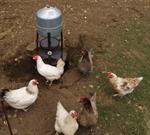What Animals Eat
 Some animals eat plants, others eat animals; and some may eat both.
Some animals eat plants, others eat animals; and some may eat both.
Animal foods, much like human food, is generally composed mainly of protein, carbohydrates, lipids (Fats), minerals, vitamins and water.
All foods are different in their composition; and the type of food that is suitable for feeding one animal species, may be totally inappropriate for a different animal. Some types of food, including legumes and animal muscle, will often have a high proportion of protein; while other foods including fruits, may contain relatively higher levels of carbohydrate and lower levels of protein.
Eating and Drinking Adaptations
All animals must feed in order to replenish stores of sugars and fats which are converted into energy. Some animals can survive longer than others between meals. Larger animals need to eat greater amounts of food whereas smaller animals need to eat more frequently since they cannot store as much energy in their bodies.
Different feeding behaviours have developed through evolution. For example, the earliest forms of land-based vertebrates were piscivores - which were large amphibians. These amphibians continued to feed on fish and insects, but some reptiles began to eat other food types. They developed a taste for tetrapods. In other words they became carnivorous. Later they also began to eat plants and so added herbivory. The way that an animal specialises towards a specific food source is one of the main reasons underlying evolution in terms of their form and function. For example:
- Beaks – the development of the beak in certain birds such as hawks, woodpeckers, pelicans, and humming birds has become specialised for specific feeding tasks like tearing flesh, tunnelling for insects in dead trees, scooping up fish, and probing flowers for nectar.
- Mouths and teeth - in animals these have also evolved differently to match different types of feeding behaviour e.g. in vampire bats, whales, leeches, cats and fish.
- Claws - these have developed in some animals as a way to catch and kill prey, such as the retractable claws of cats.
- Camouflage - this allows some animals to change colour e.g. the blue ringed octopus or chameleon in order to surreptitiously snare prey. Others use camouflage to avoid becoming a food source e.g. many moths.
- Digestive system - some animals have developed specialised digestive systems to enable them to consume certain foods. For example, herbivores and ruminants. Ruminants are mammals have an unusual digestive system. They include sheep, goats, cattle, giraffes, yaks, llamas. Food is softened by bacterial action within their stomach’s first compartment. They then regurgitate the semi-digested mass, which is called the cud. This is then chewed once again, which is known as 'ruminating'.
To learn more about animals look at our courses:
For Farm Animals click here
For Pets click here
For Wildlife click here
[31/12/2025 16:28:41]